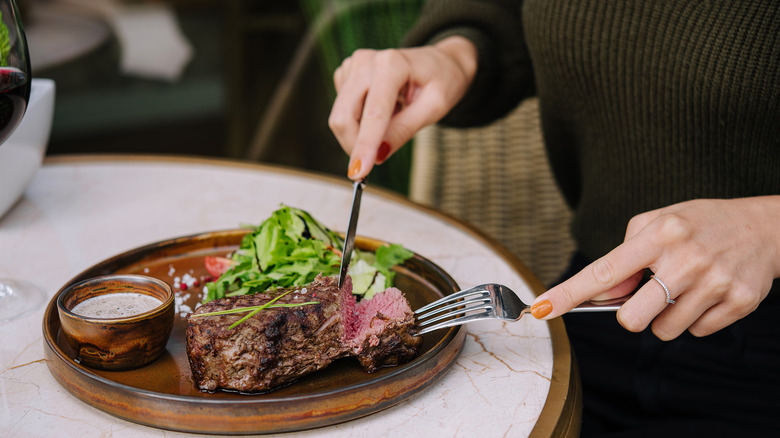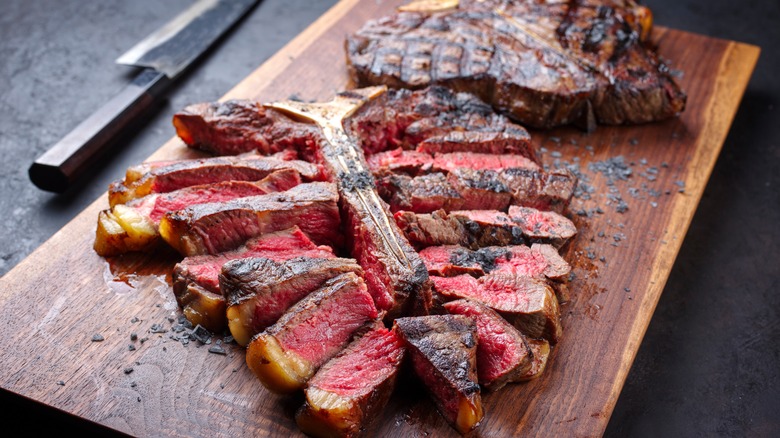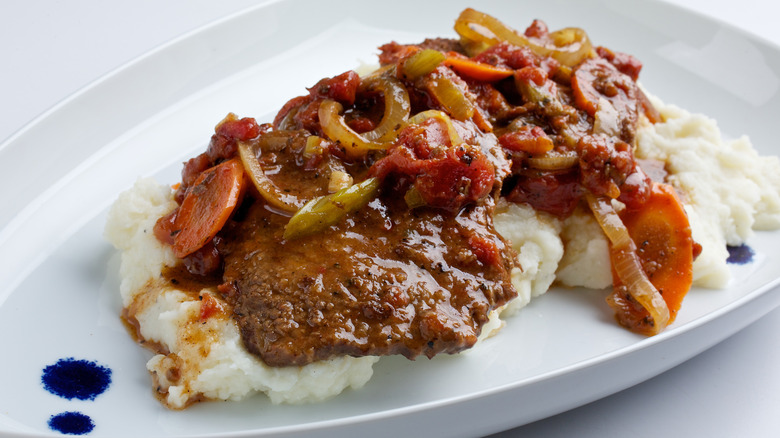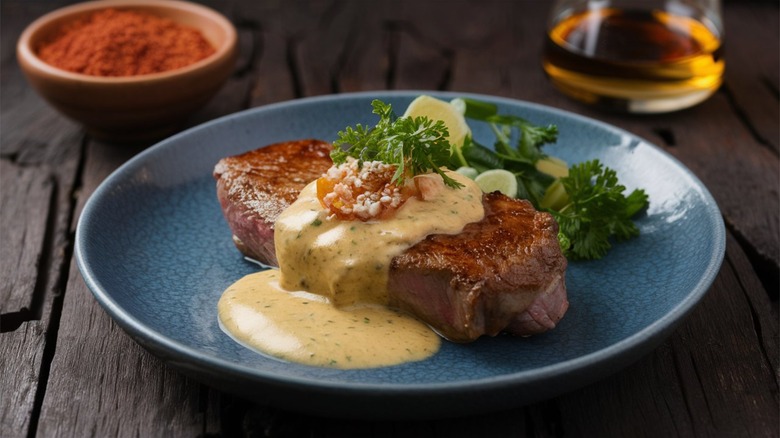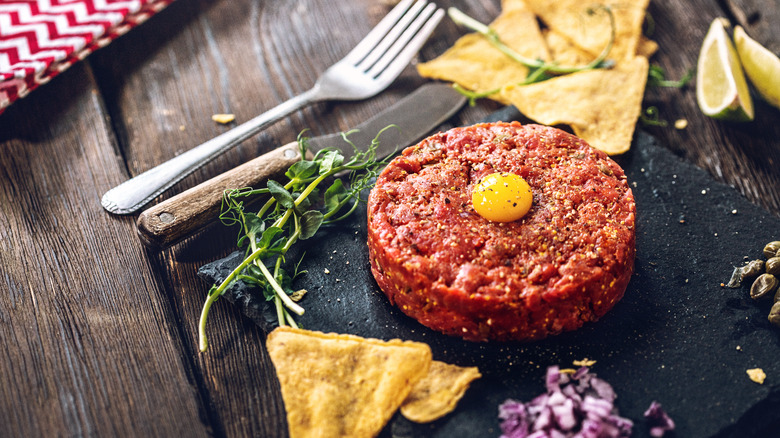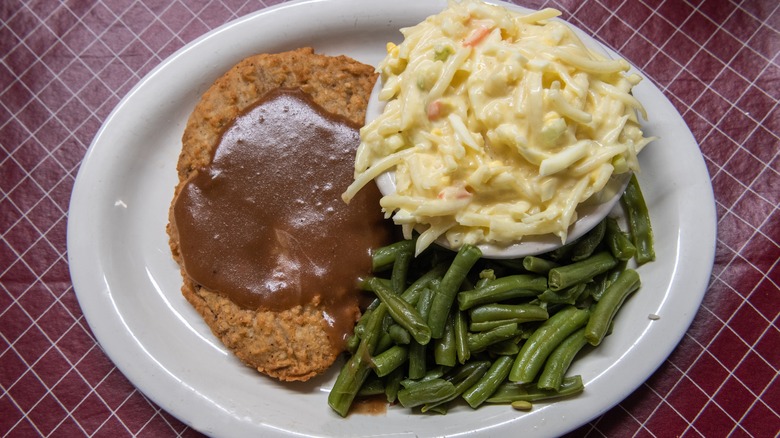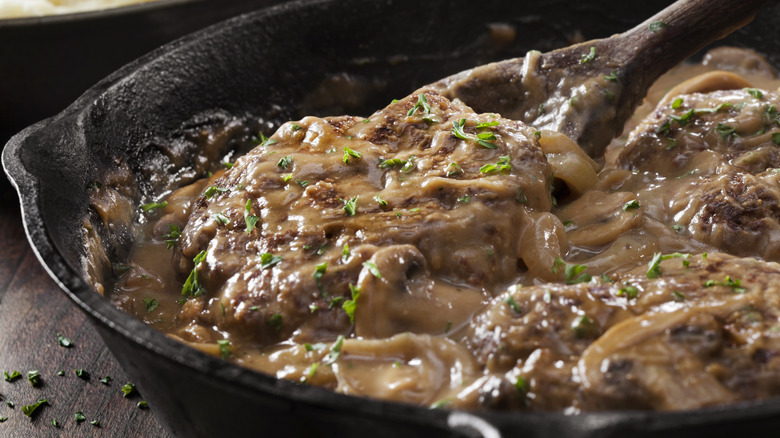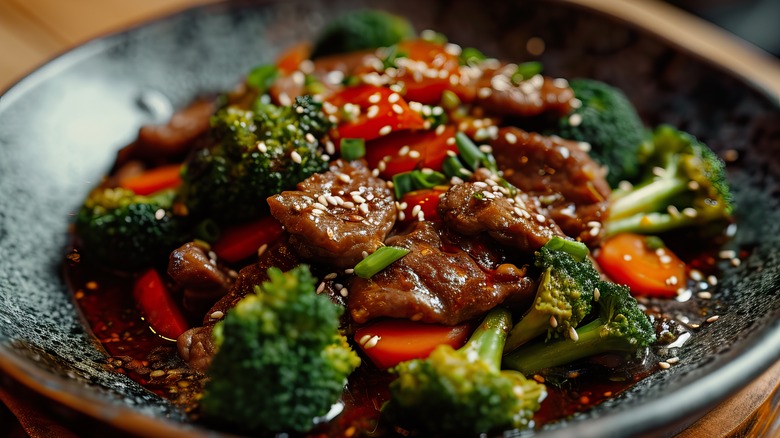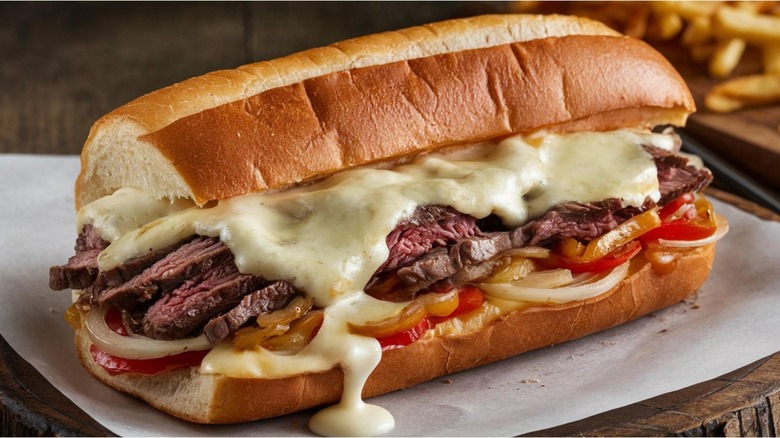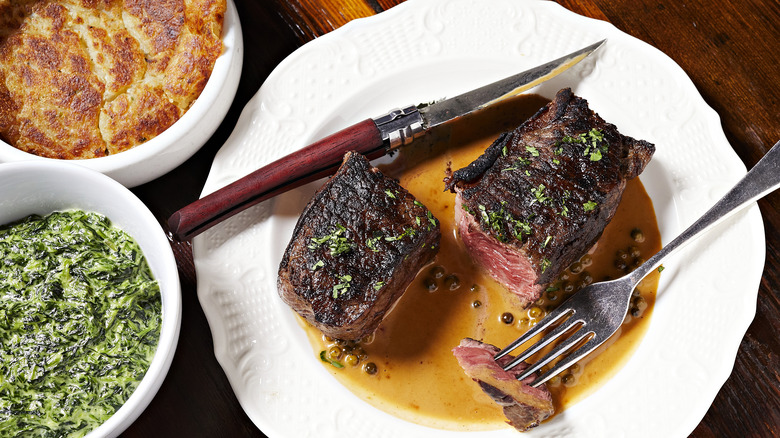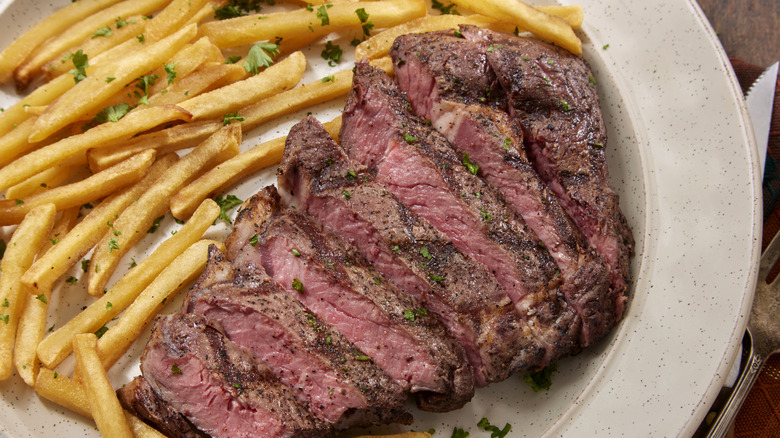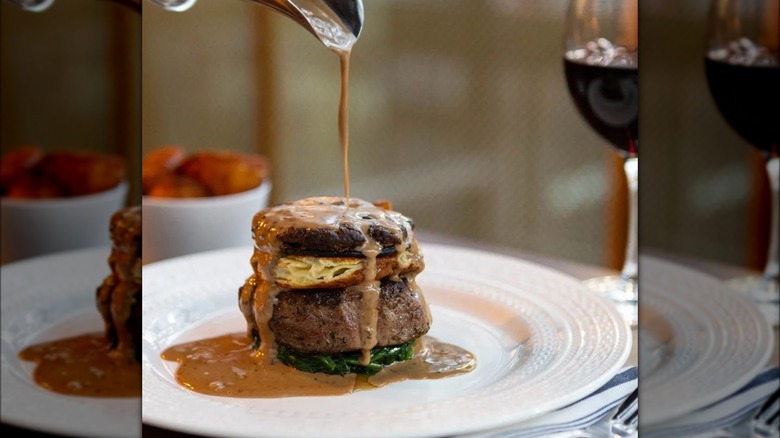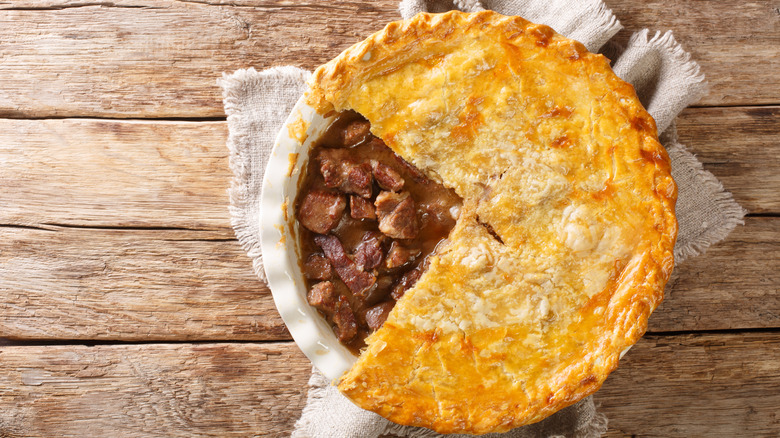The World's Oldest Steak Dishes Might Surprise You
There are so many recipes and dishes out there that people enjoy every single day, yet they have no idea that the origins of those dishes stem back to years before they were born. Especially when it comes to food eaten in America — many of the popular dishes come from other countries, and have a long history behind them.
Now, when it comes to steak, there are many different ways to eat the delicious meat. More commonly, like at steakhouse restaurants, you usually just get your choice of steak grilled or cooked a certain way with a bunch of sides. It's a delicious yet basic way to enjoy a steak. Now, if you think back to recipes that say your grandmother has cooked for you with steak, or steak dishes at other types of restaurants, you may have experienced more than just a steak and a side dish.
From the classic steak frites to British steak and ale pie, we're diving into the history of some of the world's oldest but most famous steak dishes. Try not to let your mouth water too much as you read, and make sure you're prepared for an intense craving for steak after this.
Bistecca alla Fiorentina
Bistecca alla Fiorentina comes from, you guessed it, Florence. It's a popular dish in Tuscany that is traced all the way back to the year 1565. As the tale goes, the daughter of the Duke of Florence had a wedding. The celebration was held in piazza San Lorenzo, a very large and city-centered plaza in Florence, and to feed the guests — the full meat of an ox was roasted right in the center of the plaza. Apparently, English guests were in attendance, and through their hunger they chanted "beef steak!" which in Italian is "bistecca."
Bistecca alla Fiorentina, or beef-steak from Florence, is cut specifically from the area above the round of the meat and below the rib cage. It's a T-bone steak, and has fillet on one side and sirloin on the other. Traditionally cooked over an open flame (in restaurants today you'll see it on the grill), the steak is served crispy and browned on the outside but very rare on the inside. Then, it's usually garnished with some herbs and a drizzle of olive oil.
If you ever visit Tuscany, you will most likely see bistecca alla Fiorentina on many of the menus (especially if the restaurant is serving traditional Tuscan food). As for the United States, you can get this historical dish from many traditional Italian restaurants throughout the country. If you're a fan of rare steak, this may be the perfect dish for you.
Swiss steak
Swiss steak is known to be a comforting, easy to make meal. This dish is made by first slicing the steak (any classic cut of steak will do) and then tenderizing it with a swisser tool. Then, it's coated in flour and browned on the stove with a fair amount of oil. After that, the meat is braised with tomatoes, onions, celery, carrots, and beef stock. Some recipes add other seasonings like herbs, spices, and even Worcestershire sauce.
This dish is incredibly savory, chock full of vitamins and minerals from the vegetables and the meat, and has been enjoyed around the world for many years. The origins of this dish may not actually be from Switzerland, funnily enough. It is speculated that this dish actually began in England in the early 1900s, and it was named "Swiss steak" because of the tenderizing method of the meat, which the English call "swissing."
A recipe for Swiss steak was featured in a 1958 edition of the "Good Housekeeping Cookbook," and it seems that this was a very popular dish around that time. Somehow, this dish has gotten lost over the years and isn't as popularly cooked nowadays. Many people on the internet share their nostalgia for this meal, and even refer to it as a vintage recipe.
Steak Diane
Steak Diane is a dish that became popular in New York City in the '40s. Although the origins are a bit cloudy, people believe that the dish was specifically noticed to surface in The Drake Hotel in Manhattan. The meal was allegedly named after Lady Diana Cooper, a well-known actress and aristocrat in London, England. The dish was also apparently popular around the '40s and '50s in Australia and Europe as well. Other people believe that there are Roman origins to Steak Diane. With many theories going around about this dish's existence, we don't think we'll ever know the true history. What we do know, however, is that it is an incredibly delicious way to serve a steak.
Steak Diane can still be found on menus at various restaurants throughout the U.S., including The Cheesecake Factory that serves its own twist on the dish. The dish itself is quite simple, and only takes about 30 minutes to make. It can be made with filet mignon that you can cut and tenderize into medallions. Those pieces of meat are pan fried, and can then be cooked with a sauce made from the steak juices, cream, brandy, and Worcestershire sauce. It is popularly served with side dishes like mashed potatoes, steak fries, or vegetables. The creamy yet savory sauce matched with the juicy flavors of the steak create a delicious dish.
Steak tartare
It's impossible to say "steak tartare" without putting on an overly-snooty accent to say it. This dish has always been more of a delicacy, and is commonly served in French restaurants or expensive steakhouses. Steak tartare is made with with raw steak, egg yolk, mustard, herbs, and spices. Many people get turned off at the thought of eating both raw steak and raw egg yolk, but when you taste it, it's a whole different story.
Steak tartare has a rich history, and early versions of this dish were actually eaten by nomadic Tatars (Turkic speaking people) in central Asia. In about the 17th and 18th century, the consumption of raw meat was brought over to Europe, and the name "tartare" is most likely derived from the Tatars. The version of this dish that we know and love today was created by the French, and was refined with the raw egg and other flavorful ingredients in the late 19th century to early 20th century.
Today, almost every French restaurant that you go to will offer this dish. You will most likely see it served as an appetizer, but be prepared that it isn't a cheap one. Steak tartare is sold from anywhere between $25 to $35 on average. If you've never tried it, definitely save up your extra dollars and splurge for the appetizer at your next visit to a steakhouse or French bistro.
Country fried steak
Moving away from the more refined steak dishes, we have country fried steak. This is a dish you've probably had at Cracker Barrel or Texas Roadhouse. It's a decadent dish that is usually made with cube steak that gets breaded and fried, and then is topped with a brown colored gravy mainly derived from the pan drippings. Not to be confused with chicken fried steak – which actually isn't chicken at all. It's also a cube steak that is breaded, however the breading is done in a thicker manner with eggs to help solidify the crispiness. The sauce used on chicken fried steak is a white, peppery sauce.
Even though people immediately think of the Southern United States when country fried steak is mentioned, it is actually derived from Germany — Wiener schnitzel, the dish is called. That dish is basically the same as country fried steak, but it's made with veal. It's not clear when country fried steak made its way over to America, but there are generations and generations of people who have their own family recipes creating variations on the dish.
Salisbury steak
Many people are familiar with Salisbury steak, as it's a common recipe that people make at home for their families. The sneaky thing about the dish is that it's not actually steak — it's made from ground beef. However, it's cooked in a way where it's hard to differentiate the meat from a burger patty or steak. The dish is basically the ground meat cooked into patties with brown gravy and a side dish like mashed potatoes or vegetables.
This dish was originally created during the Civil War in the United States, and was used to give soldiers a nutrient-dense meal while in combat. The soldiers were suffering with malnutrition and disease, so Dr. James Henry Salisbury (who specialized in digestion and nutrition) set out to try to help improve the health of the soldiers. He realized that chopped beef was easier for the soldiers to digest compared to the other foods that they were eating. Named after Dr. Salisbury himself, this dish was easy to make and provided the soldiers with a comforting, tasty meal that would actually help keep them healthy during the war.
Beef and broccoli
If you're a fan of Chinese takeout, you've probably had beef and broccoli. What you may not know, however, is that this dish is commonly made with flank steak. This stir-fried dish features a brown sauce that is made with a mixture of soy sauce, oyster sauce, stock, sugar, and other ingredients. It's then fried together with the steak, broccoli, onions, garlic, and ginger.
Although this dish is widely connected to Chinese cuisine, it's actually not a dish that comes from China itself. When large numbers of immigrants from China arrived in San Francisco in the 1800s, they made unique dishes with the food that America had to offer. At the time, the over abundance of American beef and the excitement over a new vegetable called broccoli (which was brought over by Italian immigrants) inspired them to create the famous beef and broccoli that we know today.
People today may say that dishes like beef and broccoli from Chinese takeout aren't "authentic," however these dishes have still been around for hundreds of years, and were created by first generation Chinese Americans. So, although you may not be able to get beef and broccoli when you take a trip to China, it's still an authentically Chinese American dish with a rich history.
Philly cheesesteak
If you're lucky enough to have ever tasted an authentic Philly cheesesteak in Philadelphia itself, you know that no other sandwich will ever compare. If you haven't, let us delight you in the magic that is this East Coast delicacy. Nestled in a toasted, long roll is thinly sliced and cooked ribeye meat that is smothered in either provolone cheese or white American cheese. Many restaurants will add in some onions, tomatoes, and even lettuce. No matter how it's served, this sandwich is one of the most satisfying meals on earth.
The history of this famous sandwich dates back to the 1930s, where two brothers named Pat and Harry Olivieri are said to have run a hot dog stand in Philadelphia. They wanted to add more options to their menu, so they created a grilled beef and onion sandwich served on a roll. Then, in the 1940s, one of the managers of the brothers' restaurant added provolone to the sandwich. From there on out, the Philly cheesesteak was born. Word caught on fast, and other establishments began selling the sandwich, too. To this day, the Philly cheesesteak is a beloved sandwich that is sold all over the country.
Steak au poivre
Steak au poivre is a classic French dish. "Poivre" translates to "pepper" in English, and it is just that — peppered steak. This dish originated in the 19th century in the Normandy region of France (the North West part of the country). Apparently, because of aphrodisiac properties in black pepper, this meal was particularly popular to eat late at night. The dish then spread to Paris and Monte Carlo, and it remains a beloved dish in France still to this day.
Steak au poivre is made with filet mignon, and is then coated with a very thick layer of cracked peppercorns. It is cooked on a pan with oil or butter. The steak is then topped with a sauce that is derived from the juices from the pan mixed with wine, butter, and sometimes shallots, beef stock, and even brandy. This dish is often served with a side of fried potatoes.
Julia Child explored French cuisine in her book, "Mastering the Art of French Cooking," which she first published in 1961. She highlights steak au poivre in the cookbook, sharing, "Steak au poivre can be very good when it is not so buried in pepper and doused with flaming brandy that the flavor of the meat is utterly disguised." When looking at pictures of the dish and how it's traditionally made, it is definitely buried in pepper. Perhaps Child's palate wasn't akin to the style of this French dish.
Steak frites
Continuing with French classics, we have steak frites. This is one of the most basic steak dishes that you can get — and it's a popular choice amongst American steakhouses and French restaurants in both America and Europe. Steak frites can be made with a variety of types of steaks, usually depending on region, and can be anything from ribeye, rump, flank steak, porterhouse, or other varieties of high quality meat. The meat is usually seasoned with salt, pepper, and herbs. Many restaurants serve steak frites with some type of sauce, like a gravy sauce or buttery cream sauce.
This dish became popular in France in the 19th or beginning of the 20th century. It is said that the growth of French bistros helped grow the popularity of steak frites, because the bistros aimed to serve affordable meals for the working class. Steak frites was the perfect dish sold at these bistros because it provided nutrition and quality from the steak and the easy comfort of the fried potatoes. This dish is an oldie but a goodie, and we're sure it'll be around for years and years to come.
Gaelic steak
Jumping on over to the United Kingdom, we have Gaelic steak. This dish was apparently Queen Elizabeth II's favorite dish, and was always on the menu at her Balmoral residence in Scotland. It is made with filet mignon, onion, mushrooms, cream, chicken stock, Irish whiskey, marmite, and seasonings. It's a creamy and decadent dish that is normally served with mashed potatoes, rice, or french fries.
It is said that Darren McGrady, Queen Elizabeth II's private chef, created this recipe for the queen because she enjoyed her steak with a creamy sauce. When searching up the origins of this steak, the only thing that comes up is McGrady's recipe, or other recipes inspired by it. Whether he created this dish completely from scratch, or if it was inspired by something else, we are not sure. However, many people have been making versions of this dish at home in honor of the queen's passing, as a way to pay homage to her. It sounds like an incredibly tasty dish and a great way to remember the beloved Queen Elizabeth II.
British steak and ale pie
If you've ever seen the musical "Sweeney Todd," you know all about the popularity of meat pies in England. From pork to ground beef, there are many recipes to go around. One of the best and oldest pies is the classic British steak and ale pie. The ultimate comfort food, this pie is made with tender pieces of steak (usually chuck steak), onions, carrots, peas, garlic, tomato paste, Worcestershire sauce, and dark English ale. It's then baked into a flaky and buttery pie crust. Devouring one of these pies on a cold day in England accompanied by a pint of beer is simply the best.
Steak pies can be traced back all the way to medieval times, however it became a classic dish in British pubs in the 20th century. From pub to pub, the recipes did vary — however at the heart, they had steak, vegetables, a dark ale, and a delicious pie crust. Although the steak and ale pie may be harder to find in restaurants and pubs in the United States, it is still very much a staple on the menus in pubs over the pond.
Another similar dish to British steak and ale pie is beef and Guinness stew. It's actually made quite similarly, however it doesn't have the pie crust and has a bit more beef stock added. Whether you enjoy a pie or a stew better, this hearty meal will be sure to satisfy you on a chilly day.
